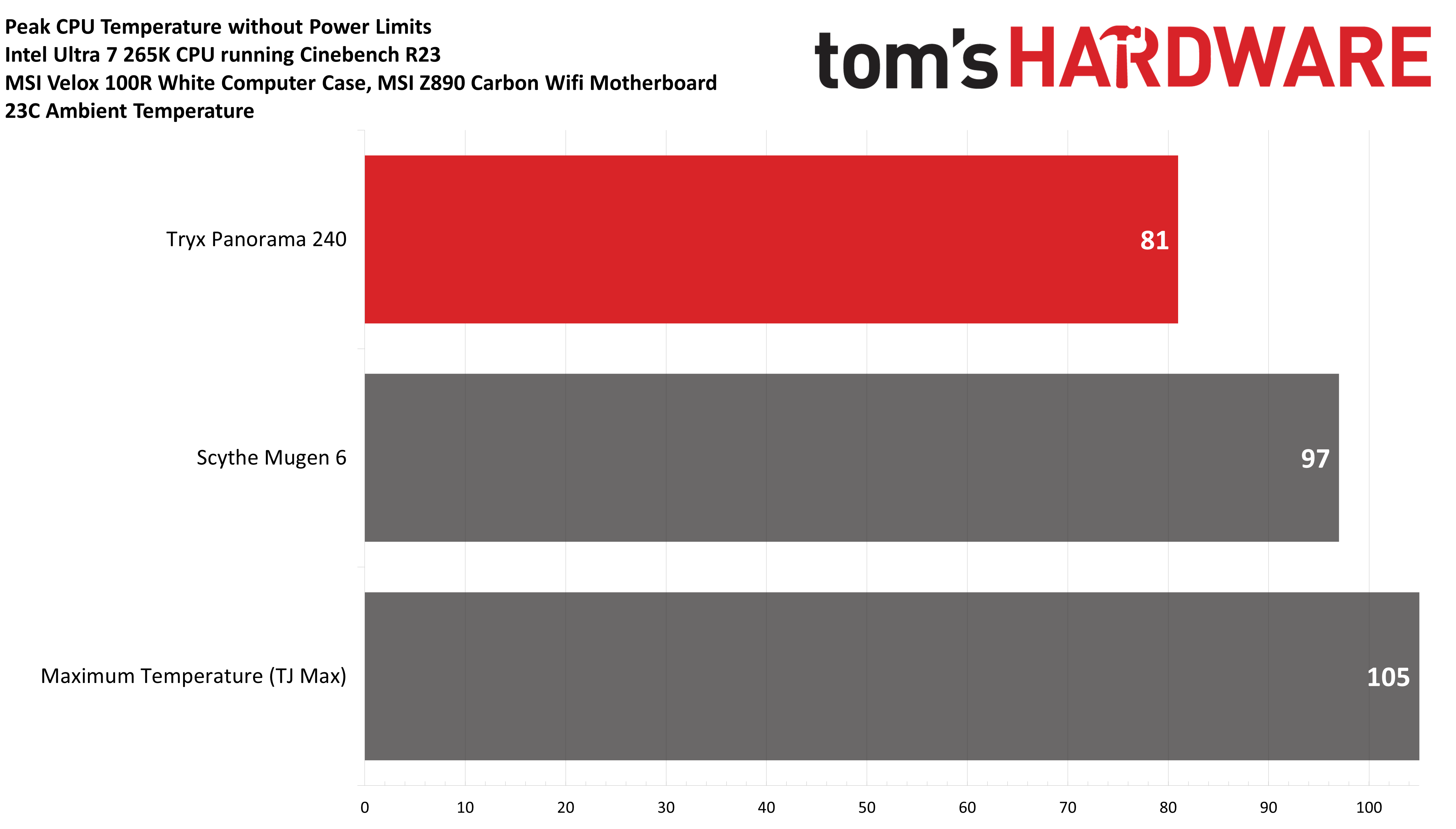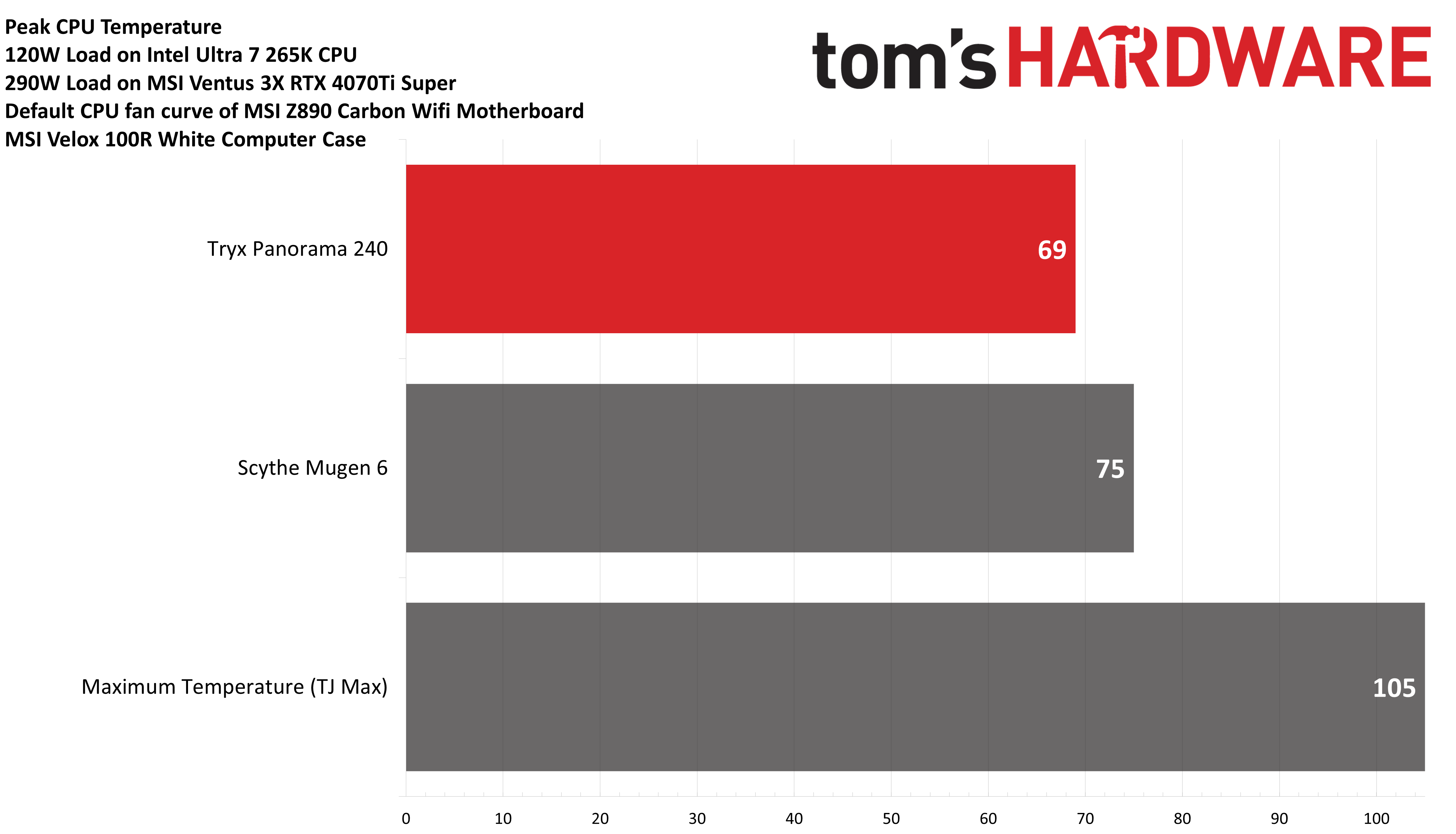The advantages of Liquid Cooling Intel’s Core Ultra 7 265K
*️⃣ Noise normalized testing
What I can tell you is that with Arrow Lake CPUs, temperatures rise 2-3C when fans are run at a whisper-quiet 35 dBA in comparison to when you run them at full speeds. This variance seems to be the same, no matter what cooler is used. I’ve tested this with both Intel’s Core Ultra 7 265K and Core Ultra 9 285K.I attempted to run noise-normalized benchmarks with the Tryx Panorama AIO, but the high minimum noise levels of the Tryx Panorama AIO prevented this sort of testing from being completed.

*️⃣ Peak CPU Temperature
The biggest advantage for liquid cooling the CPU, of course, is the reduction in peak temperature! Tryx Panorama enabled the CPU’s peak temperature to drop a whopping 16 degrees Celsius compared to an air cooler, which gives a comfortable thermal headroom margin for those interested in overclocking. Keep in mind the unit tested is only a smaller 240mm model - a 360mm AIO would very likely run a couple of degrees cooler.
*️⃣ Increased Power Consumption Efficiency
You might think that the only way a cooler impacts a CPU is with its temperature, but there’s actually more to it than that. Reduced temperatures translates into reduced electrical leakage, which in turn results in lower power consumption. How much of a reduction in power consumption will depend on the device being cooled. It’s easier to demonstrate this advantage with a GPU.
When using Tryx Panorama 240 AIO paired with Intel’s Core Ultra 7 265K, I observed a peak power consumption reduction of up to 15% compared to when the CPU runs at its peak temperature of 105C, dropping from 265W down to 234W.

Get Tom’s Hardware’s best news and in-depth reviews, straight to your inbox.
That said, the reduction in power consumption is smaller when compared to a good air cooler that can also keep the CPU under its peak temperature. Scythe’s Mugen 6 had a peak power consumption of around 247W when paired with Intel’s Core Ultra 7 265K, only about 6% higher than the Tryx AIO. It’s important to point out once more that the AIO being tested for this review is a smaller 240mm model; if I were to test with a stronger 360mm AIO the improvements here would be stronger.

120W CPU + 290W GPU results
I also wanted to see how a liquid cooler might show its advantage in gaming. In most games, the Core Ultra 7 265K will use less than 85W – but in the worst scenarios, it can peak around 120W. So for this test, I set the CPU’s power consumption to 120W and ran a full load on an RTX 4070Ti Super GPU.
The thermal gap wasn’t quite as large in this scenario. Instead of a whopping 16C, the difference between air cooling and liquid cooling was reduced to 6C – but that’s still a fairly significant gap.

Conclusion
Liquid Cooling Intel’s Core Ultra 7 265K can provide significant thermal headroom for overclocking. With Tryx Panorama 240 AIO, we observed up to a 16C reduction in temperature over air cooling. Additionally, compared to a CPU running at its maximum temperature of 105C (TJ Max), we observed a 15% reduction in CPU power consumption.For most users, I’d recommend a standard air cooler for Intel’s Core Ultra 7 265K. However, those looking for the best energy efficiency, lowest temperatures, and / or overclocking headroom would be wise to spend a little more on a good liquid cooler instead.
Current page:Advantages and Conclusion
Albert Thomas is a contributor for Tom’s Hardware, primarily covering CPU cooling reviews.